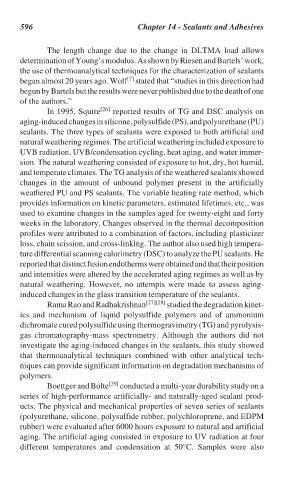Page 629 - Handbook of Thermal Analysis of Construction Materials
P. 629
596 Chapter 14 - Sealants and Adhesives
The length change due to the change in DLTMA load allows
determination of Young’s modulus. As shown by Riesen and Bartels’ work,
the use of thermoanalytical techniques for the characterization of sealants
[7]
began almost 20 years ago. Wolf stated that “studies in this direction had
begun by Bartels but the results were never published due to the death of one
of the authors.”
In 1995, Squire [26] reported results of TG and DSC analysis on
aging-induced changes in silicone, polysulfide (PS), and polyurethane (PU)
sealants. The three types of sealants were exposed to both artificial and
natural weathering regimes. The artificial weathering included exposure to
UVB radiation, UVB/condensation cycling, heat aging, and water immer-
sion. The natural weathering consisted of exposure to hot, dry, hot humid,
and temperate climates. The TG analysis of the weathered sealants showed
changes in the amount of unbound polymer present in the artificially
weathered PU and PS sealants. The variable heating rate method, which
provides information on kinetic parameters, estimated lifetimes, etc., was
used to examine changes in the samples aged for twenty-eight and forty
weeks in the laboratory. Changes observed in the thermal decomposition
profiles were attributed to a combination of factors, including plasticizer
loss, chain scission, and cross-linking. The author also used high tempera-
ture differential scanning calorimetry (DSC) to analyze the PU sealants. He
reported that distinct fusion endotherms were obtained and that their position
and intensities were altered by the accelerated aging regimes as well as by
natural weathering. However, no attempts were made to assess aging-
induced changes in the glass transition temperature of the sealants.
Rama Rao and Radhakrishnan [27][28] studied the degradation kinet-
ics and mechanism of liquid polysulfide polymers and of ammonium
dichromate cured polysulfide using thermogravimetry (TG) and pyrolysis-
gas chromatography-mass spectrometry. Although the authors did not
investigate the aging-induced changes in the sealants, this study showed
that thermoanalytical techniques combined with other analytical tech-
niques can provide significant information on degradation mechanisms of
polymers.
Boettger and Bolte [29] conducted a multi-year durability study on a
series of high-performance artificially- and naturally-aged sealant prod-
ucts. The physical and mechanical properties of seven series of sealants
(polyurethane, silicone, polysulfide rubber, polychloroprene, and EDPM
rubber) were evaluated after 6000 hours exposure to natural and artificial
aging. The artificial aging consisted in exposure to UV radiation at four
different temperatures and condensation at 50°C. Samples were also

